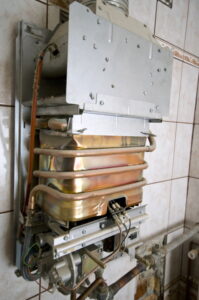 If your house doesn’t have a connection to the municipal natural gas supply, you probably use electricity to power most appliances, including the heater. The most common type of electric central heating system is the electric furnace, which works on the basic principle of electrical resistance heating. Electrical current flows through wires in the heating elements, causing the elements to heat up. The air sent through the furnace picks up heat from the surface of the elements and then continues into the ventilation system to the rest of the house.
If your house doesn’t have a connection to the municipal natural gas supply, you probably use electricity to power most appliances, including the heater. The most common type of electric central heating system is the electric furnace, which works on the basic principle of electrical resistance heating. Electrical current flows through wires in the heating elements, causing the elements to heat up. The air sent through the furnace picks up heat from the surface of the elements and then continues into the ventilation system to the rest of the house.
It’s easy to explain—not much different from how a toaster works—but there are special components involved that allow an electric furnace to work reliably and provide precision home heating. We’re going to focus on one of them in this post: the sequencer.
The Role of the Sequencer
An electric furnace is one of the most powerful home electrical appliances, consuming many volts of electricity to provide the heat necessary for comfort. If you turned on your electric furnace and it immediately drew on the maximum amount of volts needed to warm your house, sending electricity to all the heating elements, it would trip a circuit breaker in the electrical panel.
Why doesn’t it? That’s the job of the sequencer. It’s the component of the furnace that staggers how the various heating elements turn on and place demand on the electrical system. Without the sequencer to create a series of conduits, all the heating elements would receive voltage at the same time and overwhelm the circuits.
The way it works is that electricity entering the furnace moves first into the sequencer, which then routes the power to the first of the heating elements through a conduit. The sequencer will not allow voltage to move to the next element in the sequence until the conduit reaches a set temperature. The process then repeats with the next heating elements, only lifting “the gate” when the conduit is hot enough. This continues until either all the heating elements are on or the thermostat sends a signal to the sequencer to begin to cycle down the furnace.
Sequencer Troubles
When you run into problems with your electric furnace, one of the possible explanations is that the sequencer is malfunctioning or damaged and needs to be replaced. The sequencer can wear down from use and parts can corrode, and this can cause the furnace to become faulty.
For example, the furnace may no longer be able to turn on all its heating elements. If you notice your furnace isn’t keeping the house as warm as it should, it may be because the sequencer isn’t allowing it to come on all the way. The other extreme is if the sequencer stops staggering the heating elements and has them all turn on at once, causing an overload that trips the circuit breaker. If your furnace keeps causing tripped breakers, don’t try to force it to work! Call us for furnace service in Howell, MI. No matter the issue you’re experiencing with your electric furnace, we can repair it.
First Choice Heating & Cooling is here for your residential heating needs. If your home had a voice … it would call First Choice!
